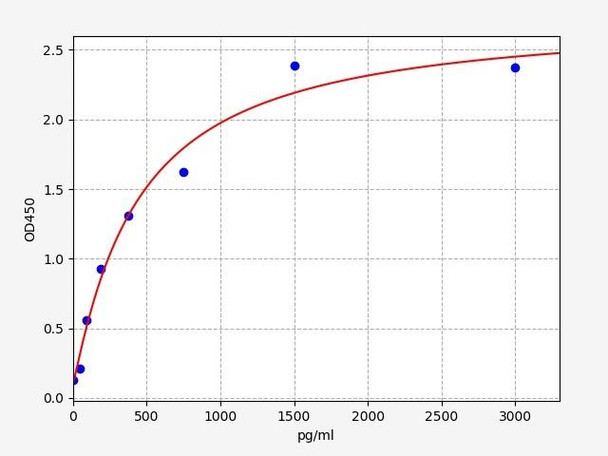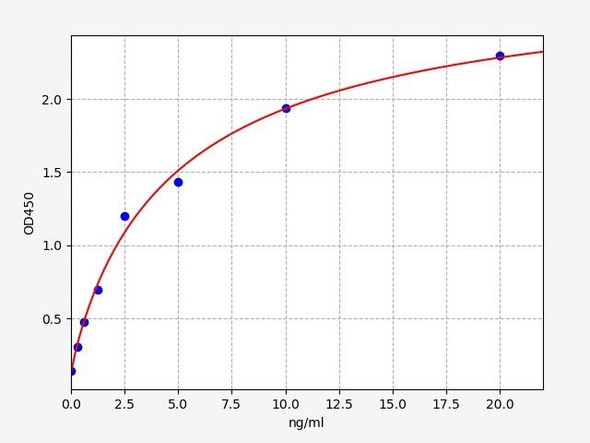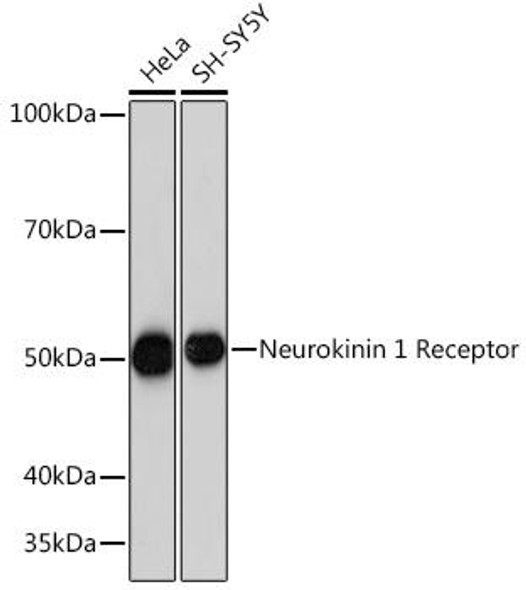Mouse NK1R(Neurokinin -1 receptor) ELISA Kit (MOFI01255)
- SKU:
- MOFI01255
- Product Type:
- ELISA Kit
- Size:
- 96 Assays
- Uniprot:
- P30548
- Sensitivity:
- 28.125pg/ml
- Range:
- 46.875-3000pg/ml
- ELISA Type:
- Sandwich
- Synonyms:
- Neurokinin-1 receptor, NK 1 receptor, NK 1R, NK1R, NKIR, SPR, Substance P receptor, TAC1R, tachykinin receptor 1, TACR1
- Reactivity:
- Mouse
Description
Mouse NK1R (Neurokinin -1 receptor) ELISA Kit
The Mouse NK1R (Neurokinin-1 Receptor) ELISA Kit is a reliable tool for the accurate measurement of NK1R levels in mouse serum, plasma, and tissue lysates. This kit offers high sensitivity and specificity, ensuring precise and reproducible results for a variety of research applications.The Neurokinin-1 Receptor is a key component in the neurokinin system, playing a critical role in regulating a variety of physiological and pathological processes, including pain perception, mood regulation, and inflammation.
Abnormalities in NK1R expression have been linked to various neurological and psychiatric disorders, making it a valuable biomarker for studying these conditions and potentially identifying new therapeutic targets.Overall, the Mouse NK1R (Neurokinin-1 Receptor) ELISA Kit is an essential tool for researchers looking to explore the role of NK1R in health and disease, providing reliable and accurate data for their studies.
| Product Name: | Mouse NK1R(Neurokinin -1 receptor) ELISA Kit |
| Product Code: | MOFI01255 |
| Size: | 96 Assays |
| Alias: | Neurokinin-1 receptor, NK 1 receptor, NK 1R, NK1R, NKIR, SPR, Substance P receptor, TAC1R, tachykinin receptor 1, TACR1 |
| Detection Method: | Sandwich ELISA |
| Application: | This immunoassay kit allows for the in vitro quantitative determination of Mouse NK1R concentrations in serum plasma and other biological fluids. |
| Sensitivity: | 28.125pg/ml |
| Range: | 46.875-3000pg/ml |
| Storage: | 4°C for 6 months |
| Note: | For Research Use Only |
| Recovery: | Matrices listed below were spiked with certain level of Mouse NK1R and the recovery rates were calculated by comparing the measured value to the expected amount of Mouse NK1R in samples. Not Available. |
| Linearity: | The linearity of the kit was assayed by testing samples spiked with appropriate concentration of Mouse NK1R and their serial dilutions. The results were demonstrated by the percentage of calculated concentration to the expected. Not Available. |
| Intra Assay: | CV <8% |
| Inter Assay: | CV <10% |
| Component | Quantity | Storage |
| ELISA Microplate (Dismountable) | 8-12 strips | 4°C for 6 months |
| Lyophilized Standard | 2 | 4°C/-20°C |
| Sample/Standard Dilution Buffer | 20ml | 4°C |
| Biotin-labeled Antibody(Concentrated) | 120ul | 4°C (Protect from light) |
| Antibody Dilution Buffer | 10ml | 4°C |
| HRP-Streptavidin Conjugate(SABC) | 120ul | 4°C (Protect from light) |
| SABC Dilution Buffer | 10ml | 4°C |
| TMB Substrate | 10ml | 4°C (Protect from light) |
| Stop Solution | 10ml | 4°C |
| Wash Buffer(25X) | 30ml | 4°C |
| Plate Sealer | 5 | - |
Other materials and equipment required:
- Microplate reader with 450 nm wavelength filter
- Multichannel Pipette, Pipette, microcentrifuge tubes and disposable pipette tips
- Incubator
- Deionized or distilled water
- Absorbent paper
- Buffer resevoir
| Uniprot | P30548 |
| UniProt Protein Function: | TACR1: This is a receptor for the tachykinin neuropeptide substance P. It is probably associated with G proteins that activate a phosphatidylinositol-calcium second messenger system. The rank order of affinity of this receptor to tachykinins is: substance P > substance K > neuromedin-K. Belongs to the G-protein coupled receptor 1 family. |
| UniProt Protein Details: | Protein type:Membrane protein, integral; Membrane protein, multi-pass; GPCR, family 1; Receptor, GPCR Cellular Component: cell surface; membrane; dendrite; cytoplasm; integral to membrane; plasma membrane; cytosol Molecular Function:G-protein coupled receptor activity; signal transducer activity; substance P receptor activity; tachykinin receptor activity Biological Process: response to nicotine; tachykinin signaling pathway; positive regulation of leukocyte migration; response to hormone stimulus; response to pain; signal transduction; sensory perception of pain; response to organic cyclic substance; positive regulation of saliva secretion; synaptic transmission; behavioral response to pain; elevation of cytosolic calcium ion concentration; regulation of smooth muscle cell migration; learning and/or memory; neuropeptide signaling pathway; positive regulation of lymphocyte proliferation; regulation of blood pressure; positive regulation of stress fiber formation; positive regulation of action potential; angiotensin mediated drinking behavior; associative learning; positive regulation of synaptic transmission, cholinergic; regulation of smooth muscle cell proliferation; eating behavior; positive regulation of synaptic transmission, GABAergic; positive regulation of hormone secretion; positive regulation of vascular permeability; positive regulation of ossification; G-protein coupled receptor protein signaling pathway; response to ethanol; long-term memory; response to heat; smooth muscle contraction involved in micturition; response to ozone; operant conditioning; positive regulation of vasoconstriction; sperm ejaculation; positive regulation of epithelial cell proliferation; positive regulation of blood pressure |
| NCBI Summary: | This gene encodes the receptor for the tachykinin, substance P, also referred to as neurokinin 1. This gene belongs to a gene family of tachykinin receptors which are characterized by interactions with G proteins and contain seven hydrophobic transmembrane regions. This receptor has been associated with nitric oxide formation, and it has been localized to cholinergic and nitrergic neurons as well as on smooth muscle cells. [provided by RefSeq, Mar 2010] |
| UniProt Code: | P30548 |
| NCBI GenInfo Identifier: | 31543840 |
| NCBI Gene ID: | 21336 |
| NCBI Accession: | NP_033339.2 |
| UniProt Secondary Accession: | P30548,Q8BYR7, |
| UniProt Related Accession: | P30548 |
| Molecular Weight: | 46,322 Da |
| NCBI Full Name: | substance-P receptor |
| NCBI Synonym Full Names: | tachykinin receptor 1 |
| NCBI Official Symbol: | Tacr1 |
| NCBI Official Synonym Symbols: | Spr; Nk1r; Tac1r |
| NCBI Protein Information: | substance-P receptor |
| UniProt Protein Name: | Substance-P receptor |
| UniProt Synonym Protein Names: | NK-1 receptor; NK-1R; Tachykinin receptor 1 |
| Protein Family: | Substance-P receptor |
| UniProt Gene Name: | Tacr1 |
| UniProt Entry Name: | NK1R_MOUSE |
*Note: Protocols are specific to each batch/lot. For the correct instructions please follow the protocol included in your kit.
| Step | Procedure |
| 1. | Set standard, test sample and control (zero) wells on the pre-coated plate respectively, and then, record their positions. It is recommended to measure each standard and sample in duplicate. Wash plate 2 times before adding standard, sample and control (zero) wells! |
| 2. | Aliquot 0.1ml standard solutions into the standard wells. |
| 3. | Add 0.1 ml of Sample / Standard dilution buffer into the control (zero) well. |
| 4. | Add 0.1 ml of properly diluted sample (Human serum, plasma, tissue homogenates and other biological fluids.) into test sample wells. |
| 5. | Seal the plate with a cover and incubate at 37 °C for 90 min. |
| 6. | Remove the cover and discard the plate content, clap the plate on the absorbent filter papers or other absorbent material. Do NOT let the wells completely dry at any time. Wash plate X2. |
| 7. | Add 0.1 ml of Biotin- detection antibody working solution into the above wells (standard, test sample & zero wells). Add the solution at the bottom of each well without touching the side wall. |
| 8. | Seal the plate with a cover and incubate at 37°C for 60 min. |
| 9. | Remove the cover, and wash plate 3 times with Wash buffer. Let wash buffer rest in wells for 1 min between each wash. |
| 10. | Add 0.1 ml of SABC working solution into each well, cover the plate and incubate at 37°C for 30 min. |
| 11. | Remove the cover and wash plate 5 times with Wash buffer, and each time let the wash buffer stay in the wells for 1-2 min. |
| 12. | Add 90 µL of TMB substrate into each well, cover the plate and incubate at 37°C in dark within 10-20 min. (Note: This incubation time is for reference use only, the optimal time should be determined by end user.) And the shades of blue can be seen in the first 3-4 wells (with most concentrated standard solutions), the other wells show no obvious color. |
| 13. | Add 50 µL of Stop solution into each well and mix thoroughly. The color changes into yellow immediately. |
| 14. | Read the O.D. absorbance at 450 nm in a microplate reader immediately after adding the stop solution. |
When carrying out an ELISA assay it is important to prepare your samples in order to achieve the best possible results. Below we have a list of procedures for the preparation of samples for different sample types.
| Sample Type | Protocol |
| Serum: | If using serum separator tubes, allow samples to clot for 30 minutes at room temperature. Centrifuge for 10 minutes at 1,000x g. Collect the serum fraction and assay promptly or aliquot and store the samples at -80°C. Avoid multiple freeze-thaw cycles. If serum separator tubes are not being used, allow samples to clot overnight at 2-8°C. Centrifuge for 10 minutes at 1,000x g. Remove serum and assay promptly or aliquot and store the samples at -80°C. Avoid multiple freeze-thaw cycles. |
| Plasma: | Collect plasma using EDTA or heparin as an anticoagulant. Centrifuge samples at 4°C for 15 mins at 1000 - g within 30 mins of collection. Collect the plasma fraction and assay promptly or aliquot and store the samples at -80°C. Avoid multiple freeze-thaw cycles. Note: Over haemolysed samples are not suitable for use with this kit. |
| Urine & Cerebrospinal Fluid: | Collect the urine (mid-stream) in a sterile container, centrifuge for 20 mins at 2000-3000 rpm. Remove supernatant and assay immediately. If any precipitation is detected, repeat the centrifugation step. A similar protocol can be used for cerebrospinal fluid. |
| Cell culture supernatant: | Collect the cell culture media by pipette, followed by centrifugation at 4°C for 20 mins at 1500 rpm. Collect the clear supernatant and assay immediately. |
| Cell lysates: | Solubilize cells in lysis buffer and allow to sit on ice for 30 minutes. Centrifuge tubes at 14,000 x g for 5 minutes to remove insoluble material. Aliquot the supernatant into a new tube and discard the remaining whole cell extract. Quantify total protein concentration using a total protein assay. Assay immediately or aliquot and store at ≤ -20°C. |
| Tissue homogenates: | The preparation of tissue homogenates will vary depending upon tissue type. Rinse tissue with 1X PBS to remove excess blood & homogenize in 20ml of 1X PBS (including protease inhibitors) and store overnight at ≤ -20°C. Two freeze-thaw cycles are required to break the cell membranes. To further disrupt the cell membranes you can sonicate the samples. Centrifuge homogenates for 5 mins at 5000xg. Remove the supernatant and assay immediately or aliquot and store at -20°C or -80°C. |
| Tissue lysates: | Rinse tissue with PBS, cut into 1-2 mm pieces, and homogenize with a tissue homogenizer in PBS. Add an equal volume of RIPA buffer containing protease inhibitors and lyse tissues at room temperature for 30 minutes with gentle agitation. Centrifuge to remove debris. Quantify total protein concentration using a total protein assay. Assay immediately or aliquot and store at ≤ -20 °C. |
| Breast Milk: | Collect milk samples and centrifuge at 10,000 x g for 60 min at 4°C. Aliquot the supernatant and assay. For long term use, store samples at -80°C. Minimize freeze/thaw cycles. |






